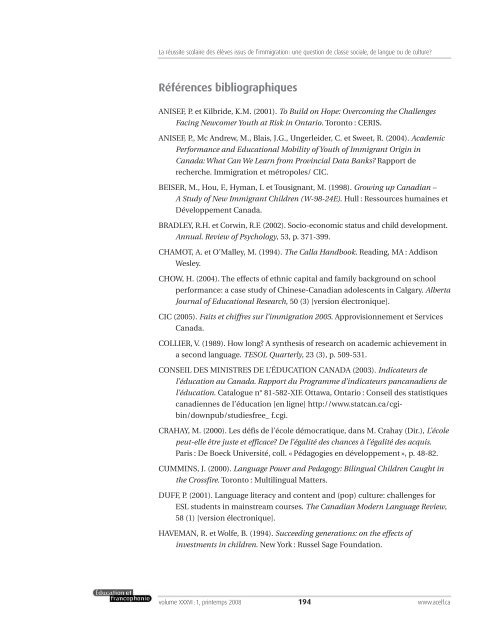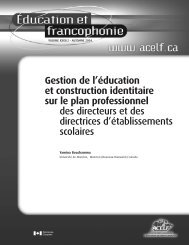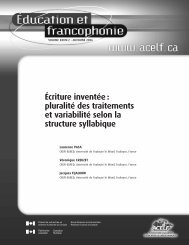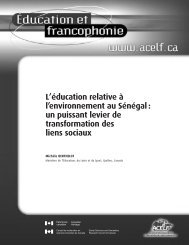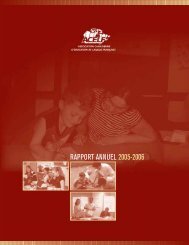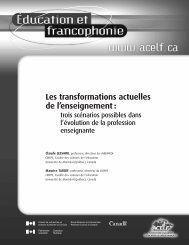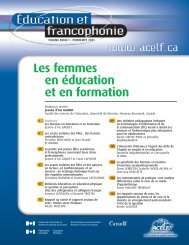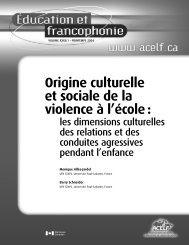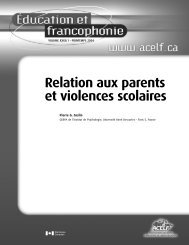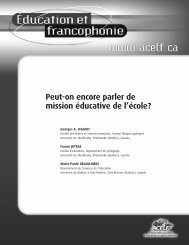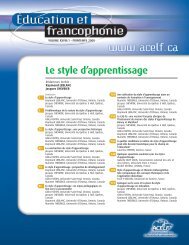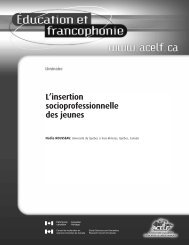La réussite scolaire des élèves issus de l’immigration : une question de classe sociale, de langue ou de culture?Références bibliographiquesANISEF, P. et Kilbride, K.M. (2001). To Build on Hope: Overcoming the ChallengesFacing Newcomer Youth at Risk in Ontario. Toronto : CERIS.ANISEF, P., Mc Andrew, M., Blais, J.G., Ungerleider, C. et Sweet, R. (2004). AcademicPerformance and Educational Mobility of Youth of Immigrant Origin inCanada: What Can We Learn from Provincial Data Banks? Rapport derecherche. Immigration et métropoles/ CIC.BEISER, M., Hou, F., Hyman, I. et Tousignant, M. (1998). Growing up Canadian –A Study of New Immigrant Children (W-98-24E). Hull : Ressources humaines etDéveloppement Canada.BRADLEY, R.H. et Corwin, R.F. (2002). Socio-economic status and child development.Annual. Review of Psychology, 53, p. 371-399.CHAMOT, A. et O’Malley, M. (1994). The Calla Handbook. Reading, MA : AddisonWesley.CHOW, H. (2004). The effects of ethnic capital and family background on schoolperformance: a case study of Chinese-Canadian adolescents in Calgary. AlbertaJournal of Educational Research, 50 (3) [version électronique].CIC (2005). Faits et chiffres sur l’immigration 2005. Approvisionnement et ServicesCanada.COLLIER, V. (1989). How long? A synthesis of research on academic achievement ina second language. TESOL Quarterly, 23 (3), p. 509-531.CONSEIL DES MINISTRES DE L’ÉDUCATION CANADA (2003). Indicateurs del’éducation au Canada. Rapport du Programme d’indicateurs pancanadiens del’éducation. Catalogue n° 81-582-XIF. Ottawa, Ontario : Conseil des statistiquescanadiennes de l’éducation [en ligne] http://www.statcan.ca/cgibin/downpub/studiesfree_f.cgi.CRAHAY, M. (2000). Les défis de l’école démocratique, dans M. Crahay (Dir.), L’écolepeut-elle être juste et efficace? De l’égalité des chances à l’égalité des acquis.Paris : De Boeck Université, coll. « Pédagogies en développement », p. 48-82.CUMMINS, J. (2000). Language Power and Pedagogy: Bilingual Children Caught inthe Crossfire. Toronto : Multilingual Matters.DUFF, P. (2001). Language literacy and content and (pop) culture: challenges forESL students in mainstream courses. The Canadian Modern Language Review,58 (1) [version électronique].HAVEMAN, R. et Wolfe, B. (1994). Succeeding generations: on the effects ofinvestments in children. New York : Russel Sage Foundation.volume XXXVI:1, printemps 2008194www.<strong>acelf</strong>.ca
La réussite scolaire des élèves issus de l’immigration : une question de classe sociale, de langue ou de culture?GARNETT, B., Adumati-Trache, M. et Ungerleider, C. (2008). The academic mobilityof students for whom English is not a first language: the roles of ethnicity,language and class. Alberta Journal of Educational Research, 54 (3).MC ANDREW, M. (2001). Immigration et diversité à l’école : le débat québécois dansune perspective comparative. Montréal : Presses de l’Université de Montréal.MC ANDREW, M. et Cicéri, C. (avec la collaboration de P. Lamarre et A. Varma)(1997). The Role of the Education in the Integration of Immigrants: CurrentResearch and Future Perspectives. Actes du séminaire en éducation, projetMetropolis. St-John, Terre-Neuve, 13 juin. Montréal : Immigration etmétropoles.MC ANDREW, M., et Ledent, J. (coll. R. Ait-Said) (à paraître 2007). Le cheminementscolaire des jeunes des communautés noires au secteur français : cohortes1994, 1995, 1996. Cahiers québécois de démographie.MC ANDREW, M., et Ledent, J. (coll. R. Ait-Said). (2006). La performance des élèvesdes communautés noires aux examens ministériels du secondaire québécois :cohortes 1994, 1995, 1996. Journal de l’intégration et de la migrationinternationale, 7 (3).MC ANDREW, M. et Ledent, J. (avec la collaboration de R. Ait-Said) (2005).La réussite scolaire des jeunes noirs au secondaire. Rapport de recherche.Chaire en Relations ethniques, Université de Montréal.OGBU, J.U. (1992). Adaptation to minority status and impact on school success.Theory into Practice, 31 (4), p. 287.OGBU, J.U. et Simmons H. (1998). Voluntary and involuntary minorities: acultural-ecological theory of school performance with some implications foreducation. Anthropology and Education Quarterly, 29 (2), p. 155-188.PENG, S.S. et Wright, D. (1994). Explanation of academic achievement of AsianAmerican students. Journal of Educational Research, 87 (6), p. 346-352.PORTES, A. (1994). The new second generation. International Migration Review,28, p. 108.PORTES, A. et Rumbaut, R. G. (1990). Immigrant America: A Portrait. Berkeley :University of California Press.PORTES, A. et Zhou, M. (1993). The new second generation: Segmented assimilationand its variants. Annals of the American Academy of Political and SocialSciences, 530, p. 74-96.PORTES, A. et Zhou, M. (1994). Should immigrants assimilate. Public Interest,94 (116), p. 18-35.SAMUEL, E., Krugly-Smolska, E. et Warren, W. (2001). Academic achievement ofadolescents from selected ethnocultural groups in Canada. McGill Journal ofEducation, 36 (1), p. 61-73.volume XXXVI:1, printemps 2008195www.<strong>acelf</strong>.ca
- Page 4:
Rapports ethniques et éducation :
- Page 7 and 8:
Les relations entrecommunautés lin
- Page 9 and 10:
Les relations entre communautés li
- Page 11 and 12:
Les relations entre communautés li
- Page 13 and 14:
Les relations entre communautés li
- Page 15 and 16:
Les relations entre communautés li
- Page 17 and 18:
Les relations entre communautés li
- Page 19 and 20:
Les relations entre communautés li
- Page 21 and 22:
Les relations entre communautés li
- Page 23 and 24:
Les relations entre communautés li
- Page 25 and 26:
Les relations entre communautés li
- Page 27 and 28:
Regards croisés sur l’inclusiond
- Page 29 and 30:
Regards croisés sur l’inclusion
- Page 31 and 32:
Regards croisés sur l’inclusion
- Page 33 and 34:
Regards croisés sur l’inclusion
- Page 35 and 36:
Regards croisés sur l’inclusion
- Page 37 and 38:
Regards croisés sur l’inclusion
- Page 39 and 40:
Regards croisés sur l’inclusion
- Page 41 and 42:
Regards croisés sur l’inclusion
- Page 43 and 44:
Regards croisés sur l’inclusion
- Page 45 and 46:
Regards croisés sur l’inclusion
- Page 47 and 48:
La dimension linguistique des enjeu
- Page 49 and 50:
La dimension linguistique des enjeu
- Page 51 and 52:
La dimension linguistique des enjeu
- Page 53 and 54:
La dimension linguistique des enjeu
- Page 55 and 56:
La dimension linguistique des enjeu
- Page 57 and 58:
La dimension linguistique des enjeu
- Page 59 and 60:
La dimension linguistique des enjeu
- Page 61 and 62:
La dimension linguistique des enjeu
- Page 63 and 64:
La dimension linguistique des enjeu
- Page 65 and 66:
La dimension linguistique des enjeu
- Page 67 and 68:
L’enseignement au Québecet en Fr
- Page 69 and 70:
L’enseignement au Québec et en F
- Page 71 and 72:
L’enseignement au Québec et en F
- Page 73 and 74:
L’enseignement au Québec et en F
- Page 75 and 76:
L’enseignement au Québec et en F
- Page 77 and 78:
L’enseignement au Québec et en F
- Page 79 and 80:
L’enseignement au Québec et en F
- Page 81 and 82:
L’enseignement au Québec et en F
- Page 83 and 84:
L’enseignement au Québec et en F
- Page 85 and 86:
L’enseignement au Québec et en F
- Page 87 and 88:
L’enseignement au Québec et en F
- Page 89 and 90:
La prise en compte de la diversité
- Page 91 and 92:
La prise en compte de la diversité
- Page 93 and 94:
La prise en compte de la diversité
- Page 95 and 96:
La prise en compte de la diversité
- Page 97 and 98:
La prise en compte de la diversité
- Page 99 and 100:
La prise en compte de la diversité
- Page 101 and 102:
La prise en compte de la diversité
- Page 103 and 104:
La prise en compte de la diversité
- Page 105 and 106:
L’éducation à la citoyennetéda
- Page 107 and 108:
L’éducation à la citoyenneté d
- Page 109 and 110:
L’éducation à la citoyenneté d
- Page 111 and 112:
L’éducation à la citoyenneté d
- Page 113 and 114:
L’éducation à la citoyenneté d
- Page 115 and 116:
L’éducation à la citoyenneté d
- Page 117 and 118:
L’éducation à la citoyenneté d
- Page 119 and 120:
L’éducation à la citoyenneté d
- Page 121 and 122:
L’éducation à la citoyenneté d
- Page 123 and 124:
L’éducation à la citoyenneté d
- Page 125 and 126:
Diversité culturelle,enseignement
- Page 127 and 128:
Diversité culturelle, enseignement
- Page 129 and 130:
Diversité culturelle, enseignement
- Page 131 and 132:
Diversité culturelle, enseignement
- Page 133 and 134:
Diversité culturelle, enseignement
- Page 135 and 136:
Diversité culturelle, enseignement
- Page 137 and 138:
Diversité culturelle, enseignement
- Page 139 and 140:
Diversité culturelle, enseignement
- Page 141 and 142:
Diversité culturelle, enseignement
- Page 143 and 144:
Diversité culturelle, enseignement
- Page 145 and 146: Relever le défi de la diversité :
- Page 147 and 148: Relever le défi de la diversité :
- Page 149 and 150: Relever le défi de la diversité :
- Page 151 and 152: Relever le défi de la diversité :
- Page 153 and 154: Relever le défi de la diversité :
- Page 155 and 156: Relever le défi de la diversité :
- Page 157 and 158: Relever le défi de la diversité :
- Page 159 and 160: Relever le défi de la diversité :
- Page 161 and 162: Relever le défi de la diversité :
- Page 163 and 164: Les relations école - famillesimmi
- Page 165 and 166: Les relations école - familles imm
- Page 167 and 168: Les relations école - familles imm
- Page 169 and 170: Les relations école - familles imm
- Page 171 and 172: Les relations école - familles imm
- Page 173 and 174: Les relations école - familles imm
- Page 175 and 176: Les relations école - familles imm
- Page 177 and 178: Les relations école - familles imm
- Page 179 and 180: La réussite scolaire desélèves i
- Page 181 and 182: La réussite scolaire des élèves
- Page 183 and 184: La réussite scolaire des élèves
- Page 185 and 186: La réussite scolaire des élèves
- Page 187 and 188: La réussite scolaire des élèves
- Page 189 and 190: La réussite scolaire des élèves
- Page 191 and 192: La réussite scolaire des élèves
- Page 193 and 194: La réussite scolaire des élèves
- Page 195: La réussite scolaire des élèves
- Page 199 and 200: La « valeur ajoutée »de l’édu
- Page 201 and 202: La « valeur ajoutée » de l’éd
- Page 203 and 204: La « valeur ajoutée » de l’éd
- Page 205 and 206: La « valeur ajoutée » de l’éd
- Page 207 and 208: La « valeur ajoutée » de l’éd
- Page 209 and 210: La « valeur ajoutée » de l’éd
- Page 211 and 212: La « valeur ajoutée » de l’éd
- Page 213 and 214: La « valeur ajoutée » de l’éd
- Page 215 and 216: La « valeur ajoutée » de l’éd
- Page 217 and 218: La « valeur ajoutée » de l’éd


